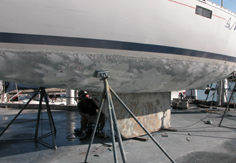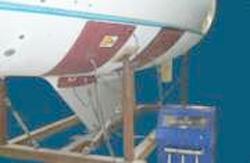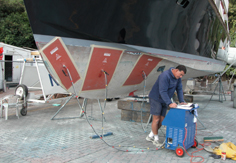 Several years ago, while surfing the internet for some new and better information about treating hull blisters, I came upon some articles by Bengt Blomberg, a Swede, who was one of pioneers in osmosis treatment. Blomberg had some unorthodox ideas on why blisters formed as well as some answers as to why we seemed unable to repair them satisfactorily for any length of time before they reappeared.
Several years ago, while surfing the internet for some new and better information about treating hull blisters, I came upon some articles by Bengt Blomberg, a Swede, who was one of pioneers in osmosis treatment. Blomberg had some unorthodox ideas on why blisters formed as well as some answers as to why we seemed unable to repair them satisfactorily for any length of time before they reappeared.
Marine Surveys by Mustin Marine Surveys, Miami, Florida, USA, Henry Mustin, NAMS® CMSAs most of you involved in the marine trades know, we have been trying to deal with osmosis, or the appearance of blisters on fiberglass hulls, for 25 years. The repairs to this problem worldwide annually run into hundreds of thousands of dollars, maybe millions, and it has spawned a repair industry unto itself. Ask anyone connected with our industry the best way to “cure” blisters, and I guarantee you will get a different opinion each time! I know this from firsthand experience, as I tried to understand the problem, in order to properly advise my own survey clients over the years.
While we labored under the thought that osmosis was a problem generated from outside a hull, it in fact appears to be a problem that exists within the laminates, long before the boat ever sees the water! And, it is a problem that affects polyester resins most severely.
 Where industry experts appear to have erred in their collective thinking is here: It was felt that osmosis had to follow voids or paths in the hull laminates (lay-up), and that these voids were the result of poor quality control by the builder. While a poorly constructed hull could influence osmosis, it is not the primary cause.
Where industry experts appear to have erred in their collective thinking is here: It was felt that osmosis had to follow voids or paths in the hull laminates (lay-up), and that these voids were the result of poor quality control by the builder. While a poorly constructed hull could influence osmosis, it is not the primary cause.
Marine Surveys by Mustin Marine Surveys, Miami, Florida, USA, Henry Mustin, NAMS® CMSIn the U.S., we do not post cure our completed hulls (at least not yet!); we rely on a normal thermo-set of the resins, mostly in a temperature-controlled factory environment. Polyester resins need to be post cured at 80º – 90º C (176° – 194° F) in order to fully cure. As the hulls have no high temperature post curing, there exists in quite a high number of hulls, some degree of styrene (as moisture), alkali, and other random, uncured components, usually sitting in “pockets”, sometimes deep in the laminate schedule, sometimes nearer the surface. In some hulls, as soon as these pockets are exposed to any moisture, a reaction called hydrolysis takes place. And hydrolysis is a nasty customer indeed! In severe cases it can reduce the bonding quality of resin, allowing the unsaturated fiberglass to become wet mush! Further complicating this mess, is the formation of pthalic acid by the hydrolysis reaction. Pthalic acid attacks the “dangling-ends”, or the portion of the cross-linked molecules that did not form a full link, due to the incomplete cure of the laminates.
 Repair techniques involved peeling, (good!), drying, either by normal temperature exposure, or with heat lamp accelerating. Following this by closely monitoring with a moisture meter, until an acceptable level of “drying” had occurred, and then repairing any blister craters, we would then apply a barrier coating, usually an epoxy. Three to five years later, more blisters appear! Why? The drying of the hull in itself cannot remove the styrene pockets, pthalic acids, glycols and other residues. It stays in the hull, and as soon as the boat is re-launched and water molecules enter the hull and mix with the residues, the hydrolysis begins again. Unfortunately, in the U.S. marketplace, many boats are re-sold before the blisters re-appear, and we surveyors are left to speculate as to what the real condition of the laminate is, lacking any laboratory analysis of a hull coupon. The new owner believes he has purchased a hull that has had a “complete” blister job, properly done, and that he or she can look forward to many trouble-free years without osmosis problems.
Repair techniques involved peeling, (good!), drying, either by normal temperature exposure, or with heat lamp accelerating. Following this by closely monitoring with a moisture meter, until an acceptable level of “drying” had occurred, and then repairing any blister craters, we would then apply a barrier coating, usually an epoxy. Three to five years later, more blisters appear! Why? The drying of the hull in itself cannot remove the styrene pockets, pthalic acids, glycols and other residues. It stays in the hull, and as soon as the boat is re-launched and water molecules enter the hull and mix with the residues, the hydrolysis begins again. Unfortunately, in the U.S. marketplace, many boats are re-sold before the blisters re-appear, and we surveyors are left to speculate as to what the real condition of the laminate is, lacking any laboratory analysis of a hull coupon. The new owner believes he has purchased a hull that has had a “complete” blister job, properly done, and that he or she can look forward to many trouble-free years without osmosis problems.
Marine Surveys by Mustin Marine Surveys, Miami, Florida, USA, Henry Mustin, NAMS® CMSAccording to Bengt Blomberg and Terry Davy, the inventor of the HotVac system, now owned by Gelplane International, a UK company, the proper treatment of osmosis blistering, or hydrolysis as it should be more properly referred to, is high temperature heat, under vacuum, at between 85º – 95º C (185° – 203° F), applied to a peeled hull, normally from 7-10 days. Now, rather than just drying the laminates, the HotVac system literally vaporizes the styrene and glycol residues, at the same time the hull is drying out. And, the process normally takes 7-10 days, rather than months of trying to get the hull to dry by conventional methods. With the HotVac system, it is perfectly reasonable to expect to make a lasting repair, including the peeling, drying, curing, repair of damage laminates, and barrier coating, in two to three weeks. Previously, this type repair could take up to six months, and still not be effective for more than a few years. The advantages in lost time of use, cost of repairs and effectiveness of repairs appear excellent. The first hulls repaired with this system have been blister free for over seven years at this writing.
The Process
The HotVac process is applied with vacuum pump machinery, with the boat on the hard, with up to four various sized pads applied to the hull. Each pad has its own heat/vacuum channel or source. After peeling, the pads are applied for 7-10 days, and the moisture measured with the Tramex Skipper meter, until dry levels (literally) are reached. The pads are moved about until the entire hull has been treated. Local repairs to deep blisters are made, and then the barrier coating completes the work.
I am not entirely sure why this system is not catching on more quickly here; there are currently only nine boatyards in the U.S. offering the treatment. Part of the problem is that the repair business for osmosis is a large one and very profitable. Why change anything? Perhaps the marketing of the product here has been poor. In Europe, the HotVac system has been well received and has a growing following in the U.K., Belgium, Holland, France and Spain. I expect there will be a considerable increase in the use of HotVac here in the next several years, as repair facilities become more conversant with it, and owners with blistered boats become aware of the HotVac process.
Henry Mustin, NAMS®-CMS
Miami & Palm Beach, Florida




